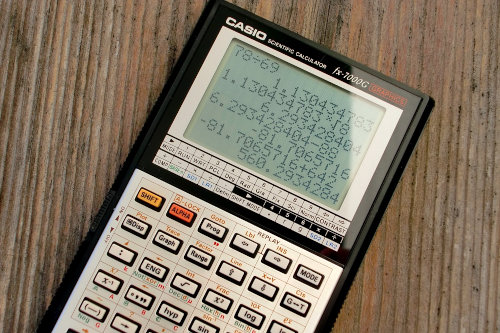In today’s digitally-driven world, technology has permeated every aspect of our lives, including education. Math tutoring, in particular, has undergone a significant transformation thanks to the integration of technology.

The era of conventional chalkboard lessons has passed; modern math tutoring now embraces technology to enrich the learning experience for learners of all ages. In this blog post, we will delve into the crucial role that technology plays in modern math tutoring, exploring how it benefits both students and educators.
Interactive Whiteboards: A Dynamic Learning Tool
One of the hallmark features of modern math tutoring is the use of interactive whiteboards. These digital boards enable tutors to create engaging and interactive lessons that go beyond the limitations of static textbooks.
With the ability to create diagrams, jot down equations, and annotate in real-time, interactive whiteboards cultivate a significantly more dynamic learning atmosphere. Students can actively participate in lessons, solve problems collaboratively, and receive instant feedback from their tutors.
Interactive whiteboards also allow for the integration of multimedia elements. Tutors can incorporate educational videos, interactive simulations, and online resources to supplement their lessons, making math more accessible and enjoyable. Additionally, these tools are particularly valuable for online math tutoring, bridging the geographical gap between tutors and students.
Personalized Learning through Adaptive Software
Technology has enabled the development of adaptive learning software that tailors math tutoring to the individual needs of each student. These programs use algorithms to assess a student’s strengths and weaknesses, adapting the content and difficulty level accordingly. For instance, if a student excels in algebra but struggles with geometry, the software will provide more challenging algebra problems and additional support for geometry concepts.
Furthermore, adaptive software offers immediate feedback, pinpointing areas where a student may be making errors and providing targeted explanations and practice exercises. This personalized approach to math tutoring can significantly accelerate a student’s progress and boost their confidence in the subject. In areas like San Diego, finding local math tutors who utilize such technology can further enhance the learning experience.
For those seeking personalized instruction, exploring options for math tutors in San Diego could be a valuable step in supplementing this adaptive software.
Video Conferencing: Connecting Tutors and Students Globally
Online math tutoring has become increasingly popular due to its convenience and accessibility. Video conferencing platforms, such as Zoom and Skype, have played a pivotal role in connecting students with qualified math tutors from around the world. This global reach allows students to choose from a diverse pool of tutors who specialize in various math topics.
Moreover, video conferencing offers a face-to-face interaction that bridges the gap between traditional in-person tutoring and online learning. Tutors can establish a strong rapport with their students, fostering a supportive learning environment where questions are encouraged and learning barriers are addressed in real-time.
Virtual Manipulatives and Simulations
Mathematics often involves abstract concepts that can be challenging to grasp through traditional methods alone. Technology has introduced virtual manipulatives and simulations that make complex math concepts tangible and comprehensible. For example, students can use virtual manipulatives to understand geometric shapes, explore the properties of three-dimensional objects, or visualize algebraic equations graphically.
Simulations, on the other hand, allow students to experiment with mathematical scenarios in a risk-free environment. They can explore probability through virtual dice rolls, witness mathematical principles in action through interactive physics simulations, or practice problem-solving skills in a gamified setting. These tools not only enhance understanding but also make learning math more engaging and fun.

Real-time Assessment and Progress Tracking
Real-time assessment and progress tracking are essential components of modern math tutoring that leverage technology to provide immediate feedback and insights into a student’s learning journey. Here’s a deeper look at these aspects:
Real-Time Assessment
- Instant Feedback: Digital platforms used in math tutoring can generate quizzes, assignments, and assessments that students complete during or after a lesson. The advantage here is that the results are available immediately. Tutors can review the answers in real-time, identify areas of difficulty, and provide instant feedback to correct misconceptions.
- Formative Assessment: Real-time assessment is a form of formative assessment, which focuses on ongoing feedback to help both the tutor and the student gauge understanding and adjust the learning process as needed. It’s not just about grading but about identifying learning gaps and addressing them promptly.
- Adaptive Learning: Some tutoring platforms use real-time assessment data to adapt the difficulty level of questions or exercises. If a student consistently performs well in a particular area, the system may provide more challenging problems, whereas if they struggle, it can offer additional practice or simpler problems until they build confidence.
Progress Tracking
- Data Analytics: Technology allows for the collection and analysis of data related to a student’s performance over time. Tutors possess the ability to track a student’s progress in various mathematical subjects, identifying trends and pinpointing areas that need improvement. Data analytics can provide a comprehensive overview of a student’s math journey.
- Personalized Learning Plans: Based on the data collected through progress tracking, tutors can develop personalized learning plans. These plans are tailored to the student’s specific strengths and weaknesses, ensuring that they receive targeted support where it’s most needed.
- Goal Setting: Progress tracking helps set and monitor achievable goals. Tutors and students can work together to define realistic objectives, and the data collected through ongoing assessments and progress tracking can be used to measure progress toward these goals.
- Motivation: Seeing their progress visualized can be highly motivating for students. When they can witness their improvement and achievements, they are more likely to stay engaged and committed to their math studies.
Parental Involvement
Progress tracking is not limited to tutors and students; it also involves parents and guardians. Many math tutoring platforms provide parents with access to their child’s performance data, allowing them to stay informed about their child’s progress, strengths, and areas that may require additional support.
This involvement facilitates better communication between parents and tutors, fostering a collaborative approach to a student’s education. Parents can offer support at home that aligns with the tutoring sessions.
Conclusion
In the modern era, technology has become an indispensable tool in the realm of math tutoring. Interactive whiteboards, adaptive learning software, video conferencing, virtual manipulatives, and progress tracking tools have transformed math education, making it more engaging, personalized, and accessible than ever before.
As we continue to embrace technological advancements, the role of technology in modern math tutoring will only continue to expand, providing students with the resources and support they need to excel in mathematics.


